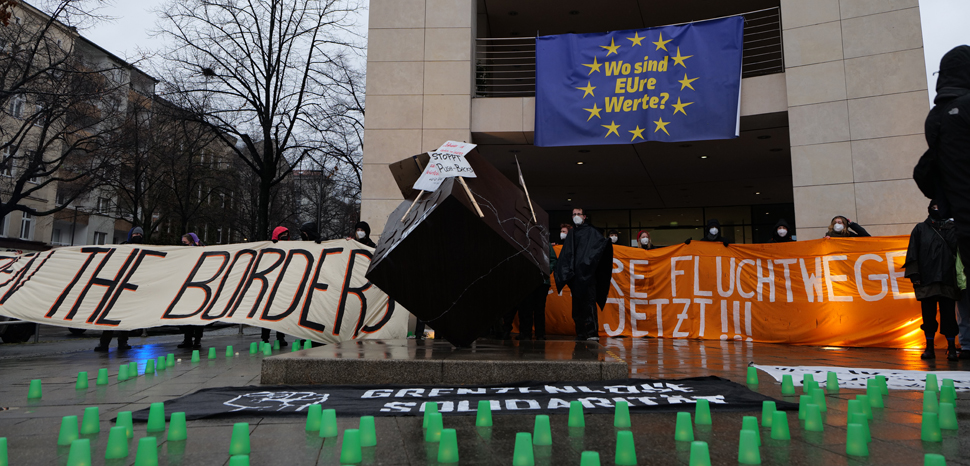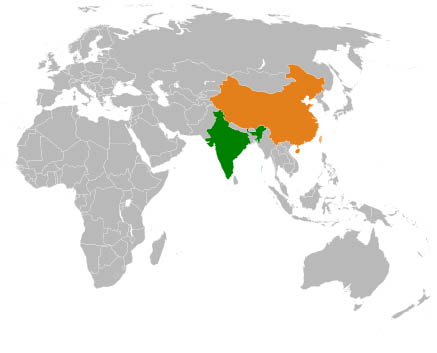All eyes are on the meeting between Russian negotiators and Ukrainian President Volodymyr Zelensky at the Ukrainian-Belarusian border. However, in light of long-time international pariah Aleksander Lukashenko’s weaponization of migrants at the Belarus-Poland border and involvement in the war, is Belarus the best location to attempt to stop Russian President Vladimir Putin’s invasion and creation of a humanitarian crisis?
As part of an effort to pressure the EU into removing sanctions and recognizing his 6th term as president, Lukashenko orchestrated the mass migration of third country nationals from Syria, Yemen, and other Middle Eastern and Northern African states. Consequently, 4000 migrants were stranded in freezing conditions without humanitarian aid. This use of coercive engineered migration to attain political and monetary concessions or achieve a goal that would be unattainable through military means is common and can occur when an asymmetrical power balance exists, and the “weaker” state inflicts costs on the “stronger” target through human demographic ‘bombs.’
Belarus’s alternative to military force is a product of the country’s lack of bargaining power compared to the world’s largest political and economic bloc, the European Union. While other countries have tried and succeeded in eliciting concessions from the EU, Lukashenko has used this strategy twice before – in 2002 and 2004. Yet, Minsk has been unable to imitate their results and a dramatic shift in EU policy has yet to transpire. The October 2021 attempt, however, signals that Belarus views conditions in the bloc to be more advantageous than previous tries.
The first perceived condition was the Union’s failed attempt at burden-sharing during the 2015 influx that saw over one million migrants entering EU territory. The unrest that followed the Arab Spring of 2011 and the Syrian civil war forced millions to flee to neighboring states like Lebanon, Turkey, and Jordan, and then to European nations. Amid the unfolding humanitarian crisis, intra-EU solidarity through burden-sharing, or refugee relocation, was at an all-time low. A proliferation of restrictive responses from individual member states followed diminishing solidarity, indicating that the European Union was unable to implement a comprehensive immigration policy in the face of mass movement.
During the EU’s burden-sharing breakdown, far-right populist groups capitalized on rising anti-immigrant sentiment across Europe. Italy’s Five Star Movement, the Alternative for Germany, and the Danish People’s Party, to name a few, exploited fears associated with immigrants and antagonized the EU’s multicultural principles. Within a few years, these parties gained enough public support to win seats in their respective countries’ parliaments and some have even become part of the ruling government, including Poland’s Law and Justice Party (PiS). Anti-migrant views and racism in European countries have become a liability as it has given authoritarian regimes, like Belarus, leverage they would not otherwise have over countries that welcomed migrants. Belarus’s sending migrants of color exacerbated European fears of terrorists posing as refugees or infiltrating refugee groups to duplicate tragedies such as the 2016 Cologne and 2018 Paris attacks.
Paradoxically, though there has been an increase in support for European far-right populist groups, the European Union is a norms-based institution. With codified juridical human rights and international migration-related commitments, there are expected behavior constraints towards migrants. The symbolic political cost of the disparity between these commitments to liberal values and to action, specifically rejecting or sending refugees to countries where they would be persecuted, was part of Belarus’s calculation. In a sense, Belarus attempted to violate and exploit the EU’s liberal norms to influence the bloc’s behavior and destabilize the border.
The last condition that Belarus sought to exploit was the EU’s reliance on preventing migrants from entering their territory, also known as externalization. In the aftermath of the Arab Spring and the 2015 influx, individual EU member states and the EU itself signed several bilateral agreements with third countries. These agreements ranged from readmission agreements between Spain and Morocco, border guard training between Italy and Libya, and resettlement agreements between the EU and Turkey. Yet each deal has had a key feature: the exchange of hosting refugees in return for monetary compensation. In 2004, President Lukashenko publicly proclaimed that “if the Europeans don’t pay, we will not protect Europe from these flows.” In the most recent attempt at coercive engineered migration, Russian Foreign Minister Sergei Lavrov referenced the EU’s externalization policy when he suggested that the European Union could provide financial assistance to Belarus to encourage it to stop migrants from crossing into the bloc.
While Belarus is hoping to capitalize on these conditions, authorities in Poland and the European Union are resisting. Poland, assisted by neighboring Latvia and Lithuania, has deployed over 20,000 border police flanked by military support to push back anyone who crosses the border. The EU has also created a blacklist of travel companies, specifically targeting airlines, involved in smuggling migrants. In response to these additional sanctions, Belarussian strongman Lukashenko threatened to halt the supply of gas from Russia to Europe. However, the threat was unfulfilled and ignored. As of February 2021, Poland has started construction of a €350 million border fence along its border with Belarus that will be equipped with cameras and motion detectors. While these methods have effectively deterred migrants, many humanitarian agencies have accused Warsaw and Brussels of violating their obligations under both the United Nations and European Union charter. Agencies say as many as 13 migrants have died while the rest are suffering in a cold forest with little food or water.
If Belarus truly believed they could bring the EU to the negotiation table by using migrants as coercion capital, rather than just political posturing, then Minsk’s perceptions of the conditions in the EU were flawed. While Poland is an EU member and should share the same norms that the bloc does, it has more authoritarian tendencies, having recently been sanctioned, among other actions, for a lack of judiciary independence. Therefore, the third condition, that argues that there would be a cost associated with behavior deviating from liberal norms, is unsatisfied. Further, Poland’s anti-migrant views, though a liability to the European integration project, did not provide Belarus the leverage they needed. Currently, at Poland’s Kuźnica border, the ruling Law and Justice Party (PiS) has prevented migrants from entering the legal jurisdiction of the EU. If PiS was not a far-right party, then migrants could have entered the bloc, panicked member states, and led to disparate policy responses. Then the EU’s ability to implement comprehensive immigration policy would have been handicapped, as it was in 2015. Therefore, the first and third conditions are also void. As for the fourth condition, as one of the most eastern EU member states, EU externalization policy to the northeast stops at Poland and the country has no bilateral agreements with third countries.
Despite Belarus’s failure, the European Union should be wary of coercive engineered migration as a strategy from other third countries and nonstate actors in the future, especially given the potential production of hundreds of thousands of Ukrainian refugees. Turkey, Morocco, and Libya have already elicited monetary compensation from the EU and member states Spain and Italy. To deter and combat this method of suasion, the EU must erode the power of migration as a weapon. If the EU can prevent the perception and treatment of an outflow as a crisis, they can diminish the ability of challengers like Belarus to use migrants as coercive instruments. Specifically, the EU can develop wide-ranging and politically acceptable contingency plans to actively cope with specific emergencies. The bloc should not wait until crises arise to make peripheral member states that are likely ports of entry aware that practical response plans exist. This contributed to the chaotic responses seven years ago. Relatedly, the EU could more actively cultivate the support of other states to share the burden in the event of influxes. Members seeking foreign aid or other forms of support might be persuaded to oblige. Regardless of the method, it is essential that the EU does not abrogate relevant humanitarian norms. This poses significant reputational cost and undermines protections for those fleeing persecution, the true victims of coercion.
Kyilah Terry graduated in May 2021 with an M.A. in German and European Studies from Georgetown University School of Foreign Service, with a focus on forced displacement, European migration policy, and U.S. refugee law. She also received a Certificate in Diplomatic Studies and a Certificate in Refugees and Humanitarian Emergencies. Currently, she serves as a U.S. Congressional fellow, a Government Relations fellow with Oxfam America, and a U.S. Institute of Peace research analyst. She writes here in a personal capacity.
The views expressed in this article are those of the authors alone and do not necessarily reflect those of Geopoliticalmonitor.com




